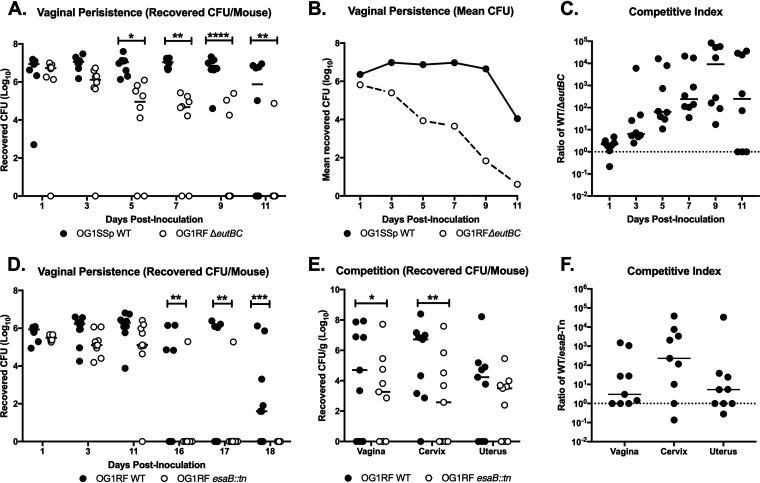FIG 6.
Ethanolamine utilization and type VII secretion system genes contribute to enterococcal persistence in the vaginal tract. (A, B, and C) C57BL/6 mice were coinoculated with OG1SSp WT and OG1RF ΔeutBC strains, and vaginal lumen was swabbed to quantify CFU. Data are presented as recovered number of CFU per swab (A), mean number of CFU recovered (B), and CI between WT and mutant strains (C). Data were analyzed using a two-way ANOVA with Sidak’s multiple comparisons; *, P < 0.05; **, P < 0.005; ****, P < 0.00005. (D) C57BL/6 mice were coinoculated with OG1RF WT and OG1RF esaB::tn strains, and vaginal lumen was swabbed to quantify CFU. Data were analyzed using a two-way ANOVA with Sidak’s multiple comparisons; **, P < 0.005; ***, P < 0.0005. (E and F) C57BL/6 mice were coinoculated with OG1RF WT and OG1RF esaB::tn strains, and reproductive tissue was collected at 11 days postinoculation. Data are presented as recovered log10 CFU/gram (E) and CI between WT and Tn mutant strain (F). CI is enumerated by calculating the ratio of WT to mutant E. faecalis recovered from the mouse reproductive tract. A CI of >1 indicates an advantage to WT E. faecalis. Values below the limit of detection were enumerated as one-half the limit of detection. Data were analyzed using a paired t test; *, P < 0.05; **, P < 0.005. Black lines indicate the median of CFU values.

